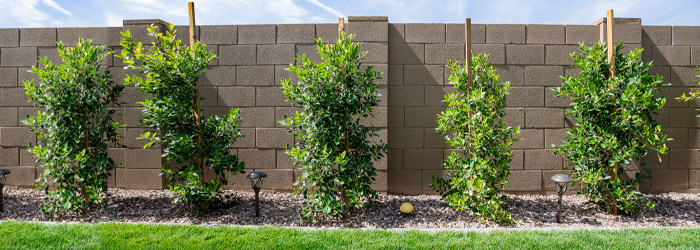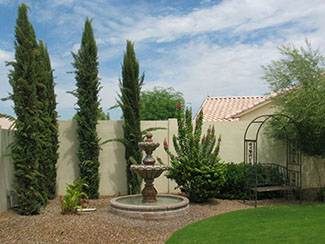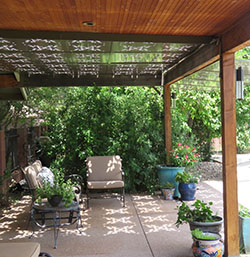Creating a Landscape to Last
 21 April 2020
21 April 2020 

Planning an aesthetically pleasing and sustainable landscape
Have you been thinking about all of the upgrades you would like to make to your landscape? Perhaps you have gone so far as to buy up local magazines, drive through neighborhoods and start a Pinterest Board in hopes of creating your dream yard. It is important to put in some time planning and researching before taking on a landscape project. A well done landscape brings enjoyment to the homeowner and adds value to the home.
We visited with Janet Waibel of Waibel and Associates Landscape Architecture this week. Waibel promotes sustainability in the urban landscape. Waibel says, "this concept is the appreciation and proper care for landscaping and plant materials with wise planning and the future in mind. Aesthetic enhancement of our outdoor urban space increases in value as it matures, thereby contributing to a healthy lifestyle."
Here are 5 basic components to think through BEFORE you start:

1 | Maintenance
How much time do you want to invest in the maintenance of your yard? Now that seems like a funny place to start, but it is a question that Janet asks of her clients. Before you even dig a hole and plant, think ahead. Once this yard is finished who is going to take care of it? Will it be you? How much time do you have to dedicate to weeding, pruning, watering or mowing? Maybe you intend to hire someone to care for it, but have you researched the available landscape maintenance people in your area? How much do they charge? The style of landscape and plants you choose, as well as how they are spaced, could have direct effects on how much maintenance is needed to achieve your desired look. It is possible once a month is not enough. These thoughtful questions give a homeowner a great place to 'weed through' the dozens of plant choices ahead of them.
2 | Installation Cost
In other words, what is your budget? Waibel recommends setting a budget and then, come to terms with the fact that most homeowners spend 15% more than they had originally planned on. Waibel suggests, "a good practice is to build a buffer by lowering your budget number leaving room for extra unpredictable expenses. The project may require more grading than was anticipated and will give you flexibility should you decide to upgrade a plant, change your mind about materials, or add an extra patio in the hardscape."
3 | Use of Property and Function
 Who will use the yard - are there children or seniors that require special consideration? Do you want a swimming pool? What kind? Is an outdoor kitchen something you'd enjoyed? Might you like a lawn? Will you play bocce ball or catch with the kids – will a small lawn do? Do you want a place to relax or visit in the shade? What will provide that shade - trees, awnings, or a nice ramada? Are you interested in edible landscaping? Your family will change over time – how might that effect your decisions? Waibel also asks her clients if there are storage considerations or privacy issues that can be addressed with landscape choices.
Who will use the yard - are there children or seniors that require special consideration? Do you want a swimming pool? What kind? Is an outdoor kitchen something you'd enjoyed? Might you like a lawn? Will you play bocce ball or catch with the kids – will a small lawn do? Do you want a place to relax or visit in the shade? What will provide that shade - trees, awnings, or a nice ramada? Are you interested in edible landscaping? Your family will change over time – how might that effect your decisions? Waibel also asks her clients if there are storage considerations or privacy issues that can be addressed with landscape choices.
4 | Irrigation
How will your yard be watered? Costs in watering systems vary; maybe you have the opportunity to take advantage of a couple types of systems. This will also impact the plants that you choose. For instance, areas depending on rainwater will require drought tolerant plants while irrigated lawns do well with fruit trees and edible landscaping.
- Flood Irrigation: If you live in an area with flood irrigation, like the Arcadia district in Phoenix, you will have more options than most. Lawns and plantings watered with good deep irrigation tend to be lush and support a wide variety of plants.
- Rainwater Harvesting: Rain harvesting is the practice of directing rain run off to water our landscape. Now is the time to watch the property for water flow after a storm. While we can't always depend on rain to be enough for our plants, there is something very responsible and satisfying about directing any runoff to provide moisture to our plants. Grading to redirect or collect water may be required.
- Irrigation System: Most yards in Arizona rely on an irrigation system for the majority of their landscape. These systems have come a long way with programmable timers, and app-based controls which can irrigate based on temperature, rainfall, and wind for maximum efficiency winter or summer.
 5 | Style
5 | Style
Having all of the major decisions of maintenance, function, budget and watering behind you makes it easier to narrow style choices. This is the fun part of the design. Before you get too far check to see if there are HOA limitations. Waibel suggests looking in your neighborhood for what makes sense and has worked well in your area. For instance, if you live in an irrigated neighborhood, a complete conversion to desert landscaping might be a stretch, and also affects the tasks necessary to maintain the new look.
One Step At A time!
Landscaping can be a costly endeavor. Consider creating your whole yard design and accomplishing your goals in phases as time and budget allow. Waibel notes that many of her clients want lighting. Lighting can be expensive and may not make it into the first round of improvements. Putting wiring in the ground at the same time that you trench for new irrigation makes it easier to add the fixtures later, without disrupting landscape areas.
Waibel shares her expertise in her book Sustainable Landscape Management: A Guide to Care in the Desert Southwest. It is a great resource for landscape professionals and homeowners to learn the basics of choosing and caring for plants in your yard.
Home Maintenance To-Do | #LandscapeArchitecture
###
Photo Credits:
- Waibel and Associates Landscape Architecture
- Shutterstock
RELATED CONTENT:
- Watershed Management
- U of A Extension Office: Home Gardening
- Water Use It Wisely: Water Plant It Wisely
- Blog: Creating Your Own Backyard Staycation
- Blog: How We're Updating Our Outdoor Living Space
- Blog: Five Ways To Cook Up Excitement At Your Next Barbecue
- Blog: Give Your Outdoor Living Room a Facelift
- Blog: Tailgating On Your Patio
- DIY FAQ: What Are the Latest Trends for Patios?
- Podcast: How We're Updating Our Outdoor Living Space
Print this page
recent post
- Duck, Duck, Duct! How Often Should Ductwork Be Cleaned?
- Vinyl vs. Fiberglass Windows: Which Is The Better Choice Of Replacement Window?
- We May Be The Grand Canyon State, But The Rocky Mountains Are Important For Arizona
- Welcome to Arizona! Things A Newbie to Arizona Should Know
- The Pros & Cons of Buying A Flipped House
- Getting In On The Ground Floor
- Why It’s More Critical Than Ever To Get Your AC Serviced Before Summer
- The Reality of Remodeling
- What To Look For When Comparing Your Roofing Quotes
- What To Expect When Buying New Windows & Doors
